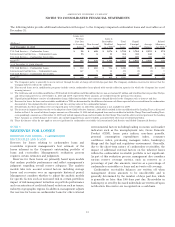American Express 2010 Annual Report Download - page 87
Download and view the complete annual report
Please find page 87 of the 2010 American Express annual report below. You can navigate through the pages in the report by either clicking on the pages listed below, or by using the keyword search tool below to find specific information within the annual report.contractual maturities because the issuers have the right to call
or prepay certain obligations.
NOTE 7
ASSET SECURITIZATIONS
CHARGE TRUST AND LENDING TRUST
The Company periodically securitizes cardmember receivables
and loans arising from its card business through the transfer of
those assets to securitization trusts. The trusts then issue
securities to third-party investors, collateralized by the
transferred assets.
Cardmember receivables are transferred to the Charge Trust
and cardmember loans are transferred to the Lending Trust. As
of December 31, 2009 and for all prior periods, cardmember
receivables transferred to the Charge Trust did not qualify as
accounting sales and accordingly, the Charge Trust was
consolidated by the Company. As a result, securitized
cardmember receivables and the related debt securities issued
to third parties by the Charge Trust were included on the
Company’s Consolidated Balance Sheets. The Lending Trust
met the criteria of a QSPE for GAAP in effect through
December 31, 2009 and, accordingly, cardmember loans
transferred to the Lending Trust qualified as accounting sales.
As a result, when cardmember loans were sold through
securitizations, the Company removed the loans from its
Consolidated Balance Sheets and recognized a gain or loss on
sale, recorded certain retained interests in the securitization
(i.e., retained subordinated securities and an interest-only strip
asset) and received an undivided pro-rata interest in the excess
loans held in the Lending Trust (historically referred to as
“seller’s interest”).
Upon adoption of new GAAP effective January 1, 2010, the
Company continues to consolidate the Charge Trust. In
addition, the Company was required to change its accounting
for the Lending Trust, which is now consolidated. As a result,
beginning January 1, 2010, the securitized cardmember loans
and the related debt securities issued to third parties by the
Lending Trust are included on the Company’s Consolidated
Balance Sheets. Prior period Consolidated Financial
Statements have not been revised for this accounting change.
The Charge Trust and the Lending Trust are consolidated by
American Express Travel Related Services Company, Inc.
(TRS), which is a consolidated subsidiary of the Company.
The trusts are considered VIEs as they have insufficient
equity at risk to finance their activities, which are to issue
securities that are collateralized by the underlying
cardmember receivables and loans.
TRS, in its role as servicer of the Charge Trust and the
Lending Trust, has the power to direct the most significant
activity of the trusts, which is the collection of the underlying
cardmember receivables and loans in the trusts. In addition,TRS
owns approximately $1.4 billion of subordinated securities
issued by the Lending Trust as of December 31, 2010. These
subordinated securities have the obligation to absorb losses of
the Lending Trust and provide the right to receive benefits from
the Lending Trust, both of which are significant to the VIE. TRS’
role as servicer for the Charge Trust does not provide it with a
significant obligation to absorb losses or a significant right to
receive benefits. However, TRS’ position as the parent company
of the entities that transferred the receivables to the Charge
Trust makes it the party most closely related to the Charge
Trust. Based on these considerations,TRS was determined to be
the primary beneficiary of both the Charge Trust and the
Lending Trust.
The debt securities issued by the Charge Trust and the
Lending Trust are non-recourse to the Company. Securitized
cardmember receivables and loans held by the Charge Trust and
the Lending Trust are available only for payment of the debt
securities or other obligations issued or arising in the
securitization transactions. The long-term debt of each trust
is payable only out of collections on their respective underlying
securitized assets.
There was approximately $9.0 million and $1.8 billion of
restricted cash held by the Charge Trust as of December 31,
2010 and 2009, respectively, and approximately $3.7 billion of
restricted cash held by the Lending Trust as of December 31,
2010 included in other assets on the Company’s Consolidated
Balance Sheets. Also, as of December 31, 2009, other receivables
on the Company’s Consolidated Balance Sheet included
$1.9 billion of restricted cash held in the Lending Trust.
These amounts relate to collections of cardmember
receivables and loans to be used by the trusts to fund future
expenses, and obligations, including interest paid on investor
certificates, credit losses and upcoming debt maturities.
85
AMERICAN EXPRESS COMPANY
NOTES TO CONSOLIDATED FINANCIAL STATEMENTS
























